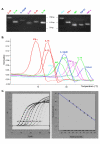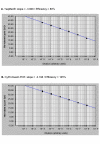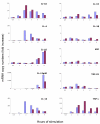CyProQuant-PCR: a real time RT-PCR technique for profiling human cytokines, based on external RNA standards, readily automatable for clinical use
- PMID: 15748278
- PMCID: PMC555737
- DOI: 10.1186/1471-2172-6-5
CyProQuant-PCR: a real time RT-PCR technique for profiling human cytokines, based on external RNA standards, readily automatable for clinical use
Abstract
Background: Real-time PCR is becoming a common tool for detecting and quantifying expression profiling of selected genes. Cytokines mRNA quantification is widely used in immunological research to dissect the early steps of immune responses or pathophysiological pathways. It is also growing to be of clinical relevancy to immuno-monitoring and evaluation of the disease status of patients. The techniques currently used for "absolute quantification" of cytokine mRNA are based on a DNA standard curve and do not take into account the critical impact of RT efficiency.
Results: To overcome this pitfall, we designed a strategy using external RNA as standard in the RT-PCR. Use of synthetic RNA standards, by comparison with the corresponding DNA standard, showed significant variations in the yield of retro-transcription depending the target amplified and the experiment. We then developed primers to be used under one single experimental condition for the specific amplification of human IL-1beta, IL-4, IL-10, IL-12p40, IL-13, IL-15, IL-18, IFN-gamma, MIF, TGF-beta1 and TNF-alpha mRNA. We showed that the beta-2 microglobulin (beta2-MG) gene was suitable for data normalisation since the level of beta2-MG transcripts in naive PBMC varied less than 5 times between individuals and was not affected by LPS or PHA stimulation. The technique, we named CyProQuant-PCR (Cytokine Profiling Quantitative PCR) was validated using a kinetic measurement of cytokine transcripts under in vitro stimulation of human PBMC by lipopolysaccharide (LPS) or Staphylococcus aureus strain Cowan (SAC). Results obtained show that CyProQuant-PCR is powerful enough to precociously detect slight cytokine induction. Finally, having demonstrated the reproducibility of the method, it was applied to malaria patients and asymptomatic controls for the quantification of TGF-beta1 transcripts and showed an increased capacity of cells from malaria patients to accumulate TGF-beta1 mRNA in response to LPS.
Conclusion: The real-time RT-PCR technique based on a RNA standard curve, CyProQuant-PCR, outlined here, allows for a genuine absolute quantification and a simultaneous analysis of a large panel of human cytokine mRNA. It represents a potent and attractive tool for immunomonitoring, lending itself readily to automation and with a high throughput. This opens the possibility of an easy and reliable cytokine profiling for clinical applications.
Figures





Similar articles
-
The use of real-time reverse transcriptase PCR for the quantification of cytokine gene expression.J Biomol Tech. 2003 Mar;14(1):33-43. J Biomol Tech. 2003. PMID: 12901609 Free PMC article.
-
Cervine (Cervus elaphus) cytokine mRNA quantification by real-time polymerase chain reaction.J Wildl Dis. 2006 Apr;42(2):219-33. doi: 10.7589/0090-3558-42.2.219. J Wildl Dis. 2006. PMID: 16870845
-
[Use of the real-time RT-PCR method for investigation of small stable RNA expression level in human epidermoid carcinoma cells A431].Tsitologiia. 2003;45(4):392-402. Tsitologiia. 2003. PMID: 14520871 Russian.
-
Transcriptional profiling of tissue plasticity: role of shifts in gene expression and technical limitations.J Appl Physiol (1985). 2005 Aug;99(2):397-413. doi: 10.1152/japplphysiol.00050.2005. J Appl Physiol (1985). 2005. PMID: 16020435 Review.
-
[Housekeeping genes as a reference in quantitative real-time RT-PCR].Postepy Hig Med Dosw (Online). 2007 Sep 28;61:500-10. Postepy Hig Med Dosw (Online). 2007. PMID: 17909518 Review. Polish.
Cited by
-
Mesoporous silica nano-adjuvant triggers pro-inflammatory responses in Caco-2/peripheral blood mononuclear cell (PBMC) co-cultures.Nanobiomedicine (Rij). 2022 Jun 3;9:18495435221088374. doi: 10.1177/18495435221088374. eCollection 2022 Jan-Dec. Nanobiomedicine (Rij). 2022. PMID: 35677573 Free PMC article.
-
Cytokine RT-qPCR and ddPCR for immunological investigations of the endangered Australian sea lion (Neophoca cinerea) and other mammals.PeerJ. 2020 Nov 13;8:e10306. doi: 10.7717/peerj.10306. eCollection 2020. PeerJ. 2020. PMID: 33240637 Free PMC article.
-
Human umbilical cord Wharton's jelly mesenchymal cell medium progress the wound healing via cytokines and growth factors expressions.Am J Stem Cells. 2025 Apr 15;14(1):14-24. doi: 10.62347/AMSW4025. eCollection 2025. Am J Stem Cells. 2025. PMID: 40400899 Free PMC article.
-
Differential immune mechanism to HIV-1 Tat variants and its regulation by AEA [corrected].Sci Rep. 2015 May 6;5:9887. doi: 10.1038/srep09887. Sci Rep. 2015. PMID: 25943894 Free PMC article.
-
Placental hypoxia during placental malaria.J Infect Dis. 2008 Mar 1;197(5):757-65. doi: 10.1086/526521. J Infect Dis. 2008. PMID: 18279052 Free PMC article.
References
-
- Aggarwal BB, Puri RK, eds . Human cytokines: their role in Disease and Therapy. Cambridge, MA: Blackwell Science; 1995.
-
- Dinarello CA. Role of pro-inflammatory and anti-inflammatory cytokines are mediators in the pathogenesis of septic shock. Chest. 1997;112:321S–329S. - PubMed
-
- Zegarska J, Paczek L, Pawlowska M, Podrzucki W, Rowinski W, Malanowski P, Wszola M, Mroz A. Quantitative gene expression of TGF-β1, TNF-α, IL-1β and IL-6 in the renal artery wall of chronically rejected renal allografts. Transplant Proc. 2002;34:3176–3179. doi: 10.1016/S0041-1345(02)03608-4. - DOI - PubMed
Publication types
MeSH terms
Substances
LinkOut - more resources
Full Text Sources
Other Literature Sources
Research Materials
Miscellaneous

